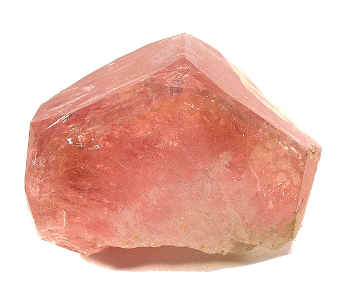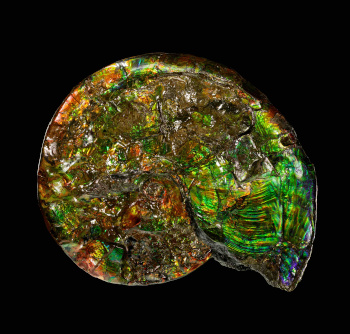Mineral Diversity
August 22, 2022
For much of my
career, I was involved in X-ray
X-ray crystallography and the
growth of
magnetic,
optical, and
piezoelectric crystals, as were many of my
colleagues. Many of these colleagues were inspired in their choice of
profession by a
childhood interest in
mineralogy, and many of them had large
mineral collections, often displayed in
showcases their
homes. At the same time that I was spending too much
money on
electronic components, they were spending about the same amount on unique
mineral specimens. Interestingly,
American financier,
John Pierpont (J. P.) Morgan (1837-1913),
had an extensive gem collection, and the mineral,
morganite, is named in his honor.

A specimen of morganite, recovered from a mine in the Southeast Region of Brazil.
Morganite, like emerald, is a crystal of beryllium-aluminum-silicate, beryl (Be3Al2(SiO3)6).
Cr3+ dopant gives emerald its green color, while Mn2+ dopant gives morganite its pink color.
Beryl minerals are formed in nature by hydrothermal growth, and this technique is used to produce synthetic versions. A carat of morganite costs several hundred dollars, an order of magnitude less than diamond.
(Wikimedia Commons image by Robert M. Lavinsky. Click for larger image.)
Modern
crystal growth technology has the capability of making
synthetic versions of minerals found in
nature, including the once elusive
diamond, often with greater
perfection. The first
solid state laser, a
ruby laser created in 1960 by
Theodore "Ted" Maiman (1927-2007), used a
synthetic ruby crystal. Ruby is
chromium-
doped sapphire, and
titanium-doped synthetic sapphire is used for
tunable lasers. While excellent quality
gems are produced synthetically, gem
marketers insist that
consumers should buy natural crystals, since they're the
real thing.
The prolific
Robert M. Hazen and colleagues have been
cataloging Earth's minerals for many years. I wrote about some of their
research in two previous articles (
Anthropocene Minerals, August 16, 2021 and
Earth's Mineral Wealth, October 19, 2015. A mineral is completely specified by its
chemical composition and
crystal structure, but a recent article has examined the many ways that such minerals are
formed.[1-2] For example,
iron pyrite, commonly called
fool's gold is formed in nature in 21 ways, the most of any mineral. Diamonds are formed in nine ways in places like
outer space and deep within the Earth.

A mineral specimen of iron pyrite, "fool's gold," the mineral type with the greatest diversity of origin.
Since the birth of the Solar System, about 4.5 billion years ago, nature has used 21 different ways to create pyrite. Pyrite forms at low and high temperatures, with and without water.
Pyrite formation can be helped by microbes, but it is found also in harsh environments where life is not present.
(Photo by ARKENSTONE/Rob Lavinsky. Click for larger image.)
The paper, published in
American Mineralogist, is a culmination of a fifteen year study led by the
Carnegie Institution for Science to detail the origins and diversity of every known mineral.[2] The research team built a
database of every process of formation of every known mineral, and it included information from the
open access mineral databases,
mindat.org and
rruff.info/ima) as well as information from thousands of
primary geology and mineral research articles.[2]
While there are about 6,000 mineral species identified by their chemical composition and crystal structure, the researchers identified 10,556 different combinations of minerals and modes of formation, what they call
mineral kinds.[1-2] Nature has used 57 processes to create these mineral kinds.[2] Minerals with 15 or more known modes of formation are pyrite,
albite,
hornblende,
corundum,
magnetite,
calcite,
hematite,
rutile, and
baryte.[1]

A specimen of the mineral, beryl (Be3Al2(SiO3)6).
Beryl is the most common mineral containing the element, beryllium. Morganite, as shown in the first figure, is also a beryl.
(Photo by ARKENSTONE/Rob Lavinsky. Click for larger image.)
The research team found that 40% of Earth's 5,659 recognized mineral species were created in more than one way, and the nine listed above were created in 15 or more ways.[1-2] The diverse processes for mineral creation range from
instantaneous lightning and
meteor strikes, to hydrothermal synthesis spanning hundreds of millions of years.[2] At least 4583 minerals, 81% of all mineral species, have been formed hydrothermally.[1] Lack of water explains why the
Moon,
Mercury and
Mars have far fewer mineral species than Earth.[2] One-third of minerals owe their creation to
biological processes, and biology has an indirect role through the creation of
Earth's oxygen-rich atmosphere and 2,000 minerals that wouldn't have formed otherwise. [2]

An opalized fossil specimen of an ammonite, a species of the class, Cephalopoda, from Alberta, Canada.
This illustrates the intersection of minerals and life.
I wrote about ammonites earlier in the year (The Largest Ammonite, January 10, 2022)
(Photo by ARKENSTONE/Rob Lavinsky. Click for larger image.)
There are 296 minerals thought to pre-date Earth, and 97 are known only from
meteorites, some of these dated as created 7 billion years ago, before the creation of the Solar System.[2] The
oldest terrestrial crystals are
zircons, first created 4.4 billion years ago.[2] There are more than 600 minerals created as a result of
human activities, including more than 500 caused by mining, and 234 from
coal mine fires.[2] There are 77
biominerals that are formed by biological processes, such as those present in
corals,
shells,
bones,
teeth and
kidney stones.[2] Seventy-two minerals derive directly or indirectly from the
guano and
urine of birds and bats, including the rare mineral
spheniscidite, a
phosphate mineral formed when the urine of
penguins reacts with
clay minerals beneath a
rookery on
Elephant Island off the
coast of
Antarctica.[2]
References:
- Robert M. Hazen and Shaunna M. Morrison, "On the paragenetic modes of minerals: A mineral evolution perspective," American Mineralogist, vol. 107, no. 7 (July 1, 2022), pp. 1262-1287, doi: https://doi.org/10.2138/am-2022-8099.
- Scientists decipher, catalog the diverse origins of Earth's minerals; will inform models of life's history, help find new minerals, habitable planets, extraterrestrial life, Carnegie Science Earth and Planets Laboratory Press Release, July 1, 2022.
Linked Keywords: Career; X-ray crystallography; crystal growth; magnetism; magnetic; optics; optical; piezoelectricity; piezoelectric; crystal; colleague; profession; childhood; mineralogy; mineral collecting; mineral collection; display case; showcase; home; money; electronic component; mineral; sample (material); specimen; America; American; financier; John Pierpont (J. P.) Morgan (1837-1913); gem collector; gem collection; morganite (gem); mining; mine; Southeast Region, Brazil; emerald; beryllium; aluminum; >silicate; beryl (Be3Al2(SiO3)6); chromium; Cr3+; activator (phosphor); dopant; Mn2+; nature; hydrothermal synthesis; hydrothermal growth; chemical synthesis; synthetic; carat (mass); United States dollar; order of magnitude; diamond; Wikimedia Commons; Robert M. Lavinsky; technology; perfection; solid state laser; ruby laser; Theodore "Ted" Maiman (1927-2007); synthetic ruby crystal; sapphire; titanium; tunable laser; gemstone; gem; marketing; marketer; consumer; Robert M. Hazen; compendium; catalog; Earth; research; chemical composition; crystal structure; chemical reaction; formation; iron pyrite; outer space; formation and evolution of the Solar System; birth of the Solar System; nature; chemical reaction; create; temperature; water; microorganism; microbe; environment (biophysical); ARKENSTONE; American Mineralogist; Carnegie Institution for Science; database; open access; www.mindat.org; rruff.info/ima/">rruff.info/ima; primary source; geology; albite; hornblende; corundum; magnetite; calcite; hematite; rutile; baryte; beryl (Be3Al2(SiO3)6); chemical element; beryllium; instant; instantaneous; lightning; impact event; meteor strike; Moon; Mercury (planet); Mars; biology; biological; atmosphere of Earth; oxygen-rich atmosphere; opalized fossil specimen of an ammonite; opal; opalized; fossil; Ammonoidea; ammonite; species; class (biology); cephalopod; cephalopoda; Alberta, Canada; life; meteorite; radiometric dating; terrestrial; zircon; Anthropocene; human activity; coal mining; coal mine; fire; biomineralization; biomineral; coral; seashell; bone; tooth; teeth; kidney stone; guano; urine; spheniscidite; phosphate mineral; penguin; clay; rookery; Elephant Island; coast; Antarctica.